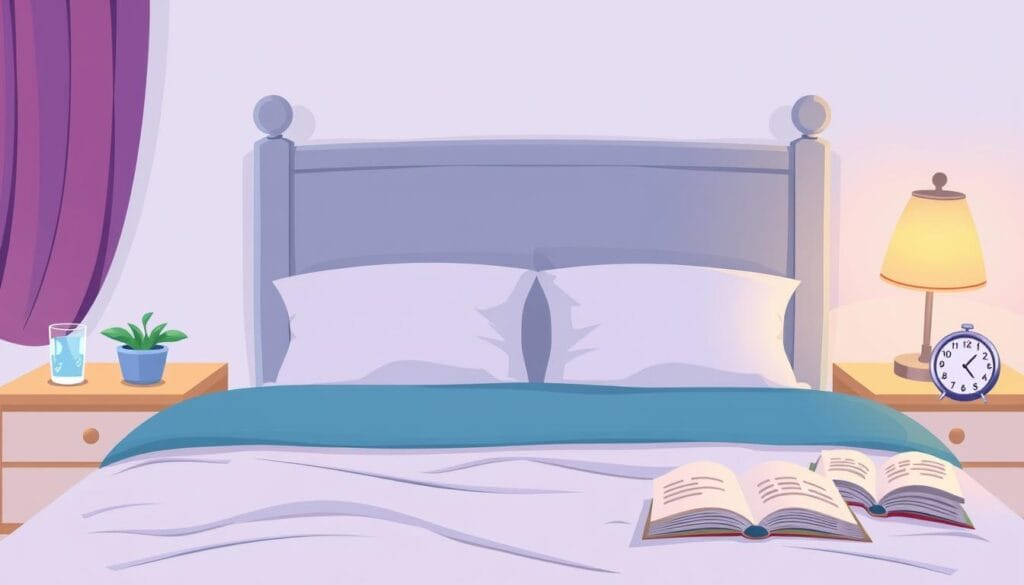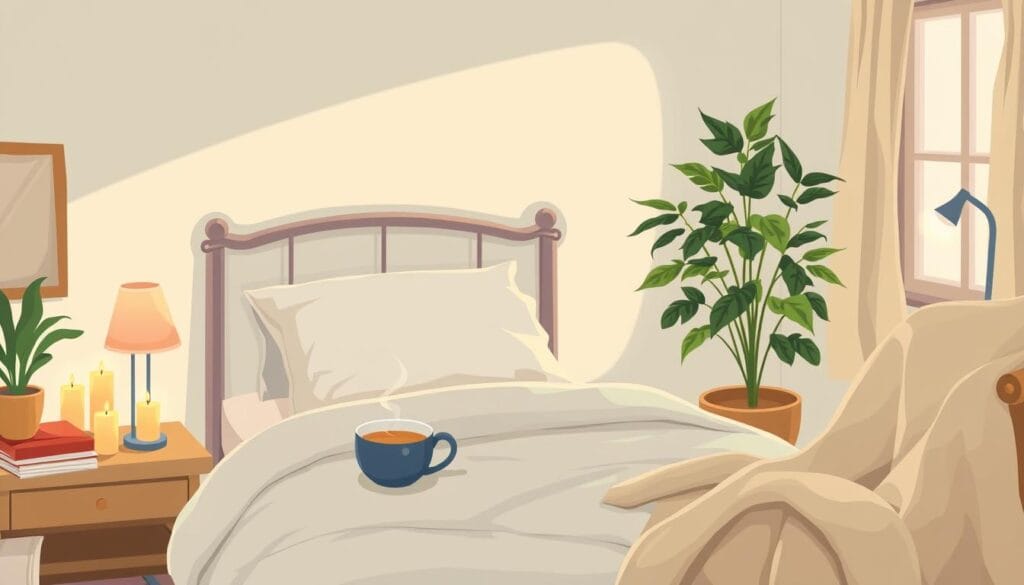Sleep is key to feeling good, but many struggle to get a good night’s rest. By using sleep hygiene techniques, you can sleep better. These methods help you create a sleep-friendly environment and routine. This leads to better health and well-being.
Studies from the Sleep Research Society and the American Academy of Sleep Medicine support these techniques. They show that good sleep habits can make a big difference. Let’s look at how prioritizing sleep can change your life for the better.
Table of Contents
Understanding Sleep Hygiene
What is sleep hygiene? It’s a set of habits and practices that help you sleep well. It’s about how our daily routines and surroundings affect our sleep. These habits come from studies on sleep, showing the need for a good sleep space and healthy habits.
Many things can change how well you sleep. Things like how much caffeine you drink, how often you exercise, and what you eat are important. Also, your sleep space like the room’s temperature, noise, and light plays a big role in falling and staying asleep.
By focusing on sleep hygiene, you can overcome today’s sleep problems. This leads to better sleep and overall health. Learning from groups like the National Sleep Foundation and the CDC helps us understand the value of these habits in our daily lives.
What are Sleep Hygiene Techniques?
Understanding sleep hygiene is key for better sleep. It’s about practices and habits that help you sleep well. Good sleep hygiene creates a peaceful space for restful sleep.
Defining Sleep Hygiene
Sleep hygiene is about behaviors and settings for good sleep. It means having a regular sleep schedule and a comfy bedroom. It also means avoiding things that can keep you awake before bed. These habits can greatly improve your sleep quality.
Common Sleep Hygiene Techniques
Using certain sleep hygiene techniques can improve your sleep. Here are some common ones:
- Stick to a regular sleep routine by sleeping and waking up at the same time every day.
- Make your bedroom a calm place that is dark, quiet, and cool.
- Don’t have too much caffeine, especially close to bedtime.
- Do relaxing things before bed, like reading or taking a warm bath.
- Keep a sleep journal to track your sleep and find what disrupts it.
By following these healthy sleep practices, you can set up a good base for better sleep at night and more energy in the morning.
The Importance of Sleep Hygiene
Sleep hygiene is key to feeling good overall. It’s not just about feeling tired or not. It affects your body and mind in big ways. Studies show that good sleep habits can bring many benefits.
Impact on Physical Health
Good sleep helps your immune system and lowers disease risk. It lets your body fix itself and feel new again. Sleep also helps your heart by lowering blood pressure and reducing inflammation.
A study in the Journal of Clinical Sleep Medicine found that bad sleep makes you more likely to get sick. This shows how important sleep is for your health.
Effects on Mental Well-being
Good sleep habits make you less anxious and happier. They help your brain work better and keep your emotions stable. This is especially important for people who are stressed or feeling down.
The World Health Organization says bad sleep can make depression worse. This shows how closely sleep and mental health are connected.

Implementing the 10-3-2-1-0 Sleep Rule
The 10-3-2-1-0 sleep rule is a simple way to improve sleep habits. It helps manage your pre-sleep routine for better rest. Each part of the rule targets habits that can ruin your sleep.
Breaking Down the Rule
The 10-3-2-1-0 sleep rule has clear guidelines for sleep:
- 10 hours before sleep: Avoid caffeine to help you sleep better.
- 3 hours before sleep: Don’t eat heavy meals to avoid discomfort.
- 2 hours before sleep: Stop work to relax and get ready for sleep.
- 1 hour before sleep: Turn off electronics and do calming activities.
- 0 distractions in bed: Make your sleep area quiet and calm.
Following the 10-3-2-1-0 sleep rule is backed by sleep research. It helps many people sleep better and feel better overall.

10 Healthy Sleep Tips for Better Rest
Improving sleep quality is about making simple changes in your daily life. By following these tips, you can sleep better. Good sleep habits include a regular routine and a cozy sleep space.
Creating a Sleep Schedule
Having a regular sleep schedule is key. Try to go to bed and wake up at the same time every day. This helps your body get into a rhythm, making it easier to sleep well.
- Find out how many hours of sleep you need, aiming for 7-9 hours.
- Choose a bedtime that lets you get this amount of sleep and stick to it.
- Short naps are okay, but avoid them late in the day to keep your sleep schedule.
Designing a Comfortable Sleep Environment
A cozy sleep space is essential for good sleep. Focus on these areas to make your bedroom a peaceful retreat:
- Keep your room cool, between 60°F to 67°F, for comfort.
- Use blackout curtains or eye masks to block out light.
- Pick a mattress and pillows that support your body while you sleep.
- Use earplugs or white noise machines to reduce noise.
By following these tips, you can sleep better. Small changes now can lead to a better night’s sleep later.

| Tip | Description |
|---|---|
| Consistent Sleep Schedule | Go to bed and wake up at the same time daily to regulate your body clock. |
| Cool Room Temperature | Keep the bedroom between 60°F and 67°F for optimal comfort. |
| Light Control | Block out light with curtains or eye masks to promote deeper sleep. |
| Comfortable Bedding | Select a mattress and pillows that suit your sleeping style for better support. |
| Noisy Environment | Reduce disruptive sounds with earplugs or white noise machines to maintain a peaceful setting. |
Nurturing a Relaxing Bedtime Routine
Creating a relaxing bedtime routine is key for quality sleep. Calming activities tell your body it’s time to rest. Simple practices can make your evenings peaceful, helping you sleep better.
Activities to Wind Down
Adding certain activities to your bedtime routine can relax you. Try these calming practices:
- Reading: Enjoy a book to relax and forget daily worries.
- Gentle Stretching: It releases muscle tension and gets your body ready for sleep.
- Meditation or Deep Breathing: These calm your mind and lower anxiety.
- Warm Bath or Shower: A warm soak relaxes you and tells your body it’s time to sleep.
Limitations on Screen Time
Reducing screen time before bed is important. The American National Sleep Foundation says blue light from screens can mess with sleep hormones. Avoiding screens for at least an hour before bed helps you wind down better.

Overcoming Common Sleep Challenges
Many people struggle with sleep challenges that make it hard to rest well. Issues like insomnia and sleep disruptors are common. Learning effective insomnia solutions and how to avoid disruptions can improve sleep quality.
Dealing with Insomnia
Insomnia often comes from anxiety, stress, or irregular sleep patterns. Cognitive Behavioral Therapy for Insomnia (CBT-I) is a top insomnia solution. It changes thoughts and behaviors that lead to sleep problems.
Mindfulness practices like meditation or deep breathing can also help. They calm the mind and prepare the body for sleep.
Avoiding Sleep Disruptors
It’s important to find and avoid sleep disruptors in your environment. Noise, an uncomfortable mattress, or poor room temperature can all disrupt sleep. Here are some tips to reduce these interruptions:
- Use white noise machines or earplugs to block disruptive sounds.
- Invest in a quality mattress and pillows that meet your comfort needs.
- Ensure the room’s temperature is cool and conducive for sleep.
Using these strategies can help overcome insomnia and improve sleep quality. Creating a peaceful sleep environment shows a commitment to wellness and better health.
| Sleep Challenge | Insomnia Solutions | Disruption Avoidance Techniques |
|---|---|---|
| Insomnia | Cognitive Behavioral Therapy (CBT-I) | Noise reduction strategies |
| Restlessness | Mindfulness meditation | Comfortable bedding |
| Nightmares | Talk therapy | Dim lighting |
Conclusion
Improving sleep hygiene is key for better well-being. By using the tips from this article, you can sleep better and feel more awake. Making small changes can greatly improve your sleep quality.
Remember, improving sleep is a journey. It’s important to face challenges and keep working on good sleep habits. Simple steps like a calming bedtime routine or a better sleep space can really help.
If you want to learn more, there are many resources out there. By focusing on sleep hygiene and trying new things, you’re on your way to better sleep. This journey will lead to healthier and more refreshing sleep.


[…] the time and resources to heal. Also, watch your lifestyle, like avoiding pollution and getting enough sleep. These can greatly improve your skin’s […]
[…] means taking care of your body through exercise, healthy food, and sleep. This balance keeps your life […]